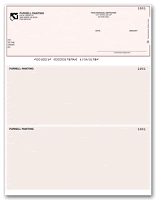While running errands this weekend I stopped by one of the large retail office supply stores. As I perused the software section I noticed a product offering the ability to print your own checks rather than purchase pre-printed checks for business use. The entrepreneur in me got a little excited, but then I started to do my homework - the marketing almost worked!
It turns out that since the inception of checks in the late 1600's the methods of making them a more secure form of payment have increase with the demands of the users. By today's standards there are more security methods than I care to try and count ensuring that forgers really have to work hard at their version of entrepreneurship! One of these security methods is something referred to as MICR (Magnetic in Character Recognition). I could attempt to relay every last detail of my reading research, but suspect that your coffee pot may start running into overtime use! So, I will boil down what I have sorted out and make my point about this "print your own checks" option.
By the year 1952 there were 47 million checking accounts with 8 billion checks written annually. On an average business day there were about 69 million checks processing through the payment system. Wow! Consider the population growth since 1952 and try to imagine what these numbers look like today... Because of the volume of check use the banking industry determined that they needed to develop an automated processing system to expedite the processing and keep up with demand. By 1956 the method of MICR was suggested and quickly implemented. There are, of course, a number of details about this special ink, but in the interest of time let me explain it the way I understand it to work. The ink contains special ingredients infusing it with magnetic attributes allowing it to stand out against other ink imprints made upon the check during processing (endorsement stamps, etc.) Combined with a special font selection and a few other features, MICR also provides a processing feature readable by both machine and human. The catch to this security and processing feature is that it requires use of a special ink. Now let's take things one step further... special ink means you also need a special type of printer in which to use it. "Special" most often also means that the ink cartridges can be quite costly. My point?
As with all business decisions - try to move past the initial marketing based excitement of a new product and investigate the details fully before making your decision. Purchasing a special printer and special ink just for printing your own checks might save you money if you print ALOT of checks routinely, but it also increases your maintenance and equipment costs. Check out all of your options and run the numbers - you might find that purchasing pre-printed business checks from a trusted supplier could save you time and aggravation in the long run without sacrificing security measures!















